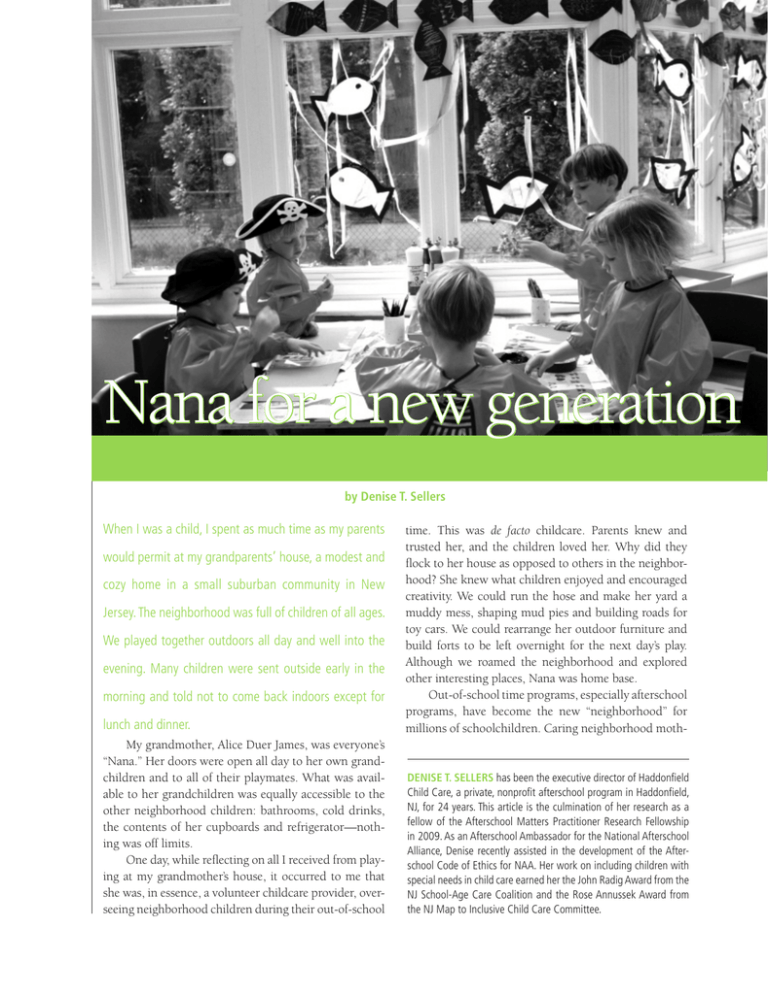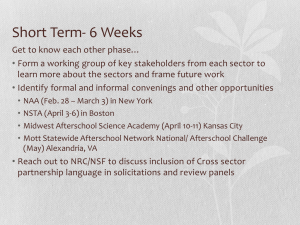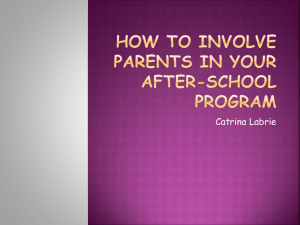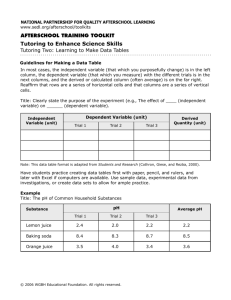Nana for a new generation - National Institute on Out-of
advertisement

Nana for a new generation by Denise T. Sellers When I was a child, I spent as much time as my parents lunch and dinner. time. This was de facto childcare. Parents knew and trusted her, and the children loved her. Why did they flock to her house as opposed to others in the neighborhood? She knew what children enjoyed and encouraged creativity. We could run the hose and make her yard a muddy mess, shaping mud pies and building roads for toy cars. We could rearrange her outdoor furniture and build forts to be left overnight for the next day’s play. Although we roamed the neighborhood and explored other interesting places, Nana was home base. Out-of-school time programs, especially afterschool programs, have become the new “neighborhood” for millions of schoolchildren. Caring neighborhood moth- My grandmother, Alice Duer James, was everyone’s “Nana.” Her doors were open all day to her own grandchildren and to all of their playmates. What was available to her grandchildren was equally accessible to the other neighborhood children: bathrooms, cold drinks, the contents of her cupboards and refrigerator—nothing was off limits. One day, while reflecting on all I received from playing at my grandmother’s house, it occurred to me that she was, in essence, a volunteer childcare provider, overseeing neighborhood children during their out-of-school Denise T. Sellers has been the executive director of Haddonfield Child Care, a private, nonprofit afterschool program in Haddonfield, NJ, for 24 years. This article is the culmination of her research as a fellow of the Afterschool Matters Practitioner Research Fellowship in 2009. As an Afterschool Ambassador for the National Afterschool Alliance, Denise recently assisted in the development of the Afterschool Code of Ethics for NAA. Her work on including children with special needs in child care earned her the John Radig Award from the NJ School-Age Care Coalition and the Rose Annussek Award from the NJ Map to Inclusive Child Care Committee. would permit at my grandparents’ house, a modest and cozy home in a small suburban community in New Jersey. The neighborhood was full of children of all ages. We played together outdoors all day and well into the evening. Many children were sent outside early in the morning and told not to come back indoors except for ers and grandmothers have been neighborhood were Nana’s chilreplaced by paid or volunteer dren. Children need cold drinks staff. One element of the past on a hot summer day, and Nana that frequently remains, espedispensed them with pleasure. cially in small programs, is the Today’s children need adults to family grouping concept. In show them that same care and many afterschool programs, affection, so I have taken up the children attend with siblings in mantle of “Neighborhood Nana” configurations similar to the for a new generation. multi-age groupings of my old Second, having had such a neighborhood. warm and comfortable environI now run just such a small ment in which to spend my own program for children of all precious out-of-school hours, I ages. After 24 years as execuwanted my own children and tive director of Haddonfield those who attended Haddonfield Child Care—a private, not-forChild Care to enjoy the same luxprofit organization with a parury. I have always intended that ent board—this role is a large my afterschool program be the part of my identity. The title best and most naturally structured and description (“Denise is diit can be for all children. I have Alice Duer as a young woman, “Nana” rector of the afterschool pronever viewed it as a “second-best” gram”) follow my name as I am option, where unfortunate chilintroduced in any community gathering. It is also a dren have to be because they have no alternative. To me, an piece of my life that can keep me up at night, as surely afterschool program is the new “neighborhood,” which can as worries about my own children or bills or other be fun and exciting while being equally safe and secure. personal commitments. What is the role of the program to families and the It is not what I trained for. Having started college in community? No doubt, there are those who would argue pre-med, I switched majors to art history. Later, as a that childcare is the foundation of our program, and that young mother, I took a different path, entering the field if it is done intentionally and well, it should be sufficient. of education. I certainly didn’t intentionally become the Promises made, promises kept: Your child is safely superdirector of an afterschool program. The career in some vised in a secure environment during the out-of-school time. ways found me, rather than the other way around. And for some parents, that might be enough. Outside Yet, as I reflect on my long career in the afterschool factors such as financial considerations or family culture field, I know that the circumstance that brought together might make a “no frills” approach their preference. If my needs as a working mother and those of a community their children are happy and safe, they are satisfied that full of working parents was a happy and appropriate one. the contracted promises have been kept. I also know that there must have been something more But the majority expect more. Many could not arthat drew me to this work and caused me to infuse it with ticulate it, but they know it when they see it. The child my own philosophy and values—to make Haddonfield who is thrilled to run into his afterschool caregiver on Child Care my own, my identity. This “something” comes the street on Saturday, the parent who is delighted that a directly from my grandmother and my mother, who made comment to a staff member about a child’s budding interchildren their priority and taught me to do the same. est in chess results in the appearance of a chess set at the program the next week—these are signals to caring parNana and Afterschool ents that their children are enjoying relationships with How did my grandmother, “Nana” to me and a neighborthe people who spend hours with them each day. These hood of children, affect my philosophy of what an afteralso reflect the characteristics of caring neighbors, and school program could be? especially of the Nana of my own youth. First and foremost, she modeled for me what a true The children themselves, as they mature and “age advocate for children should be. As the saying goes, “All out” of the program, value the fact that people who have the world’s children are my children.” The children of the been important to them in the past can be counted on to Sellers nana for a new generation 43 maintain supportive relationships in the future. I frequently have the opportunity to continue these relationships even as my students move from elementary to middle school, when most no longer participate in Haddonfield Child Care. They want to spread their wings and enjoy some freedom. Yet, as parents call to report that their children will no longer be attending, they sometimes share their angst over leaving them at home alone. I often engage them in discussion about their fears, giving them an opportunity to verbalize the pros and cons of this new independence. I let them know that our program is open to older youth, and we may discuss possible benefits of a child staying in the program even though the curriculum is mostly geared towards younger children. In other cases, I sometimes deem it appropriate to offer a second option: sending the young person to volunteer at the afterschool program a few days a week. This can provide not only some limited structure to the child’s week, but also a place to do service learning (which is often needed for church or school) and gradually build responsibility for self-care. We even brainstorm strategies for making this transition work. At this point, I frequently remind parents that this solution could lead to paid employment when children reach the age of 16 and are ready for part-time work. I encourage former participants, as they enter the high school where my office is located, to think of me and my office as a safe haven where they can find help or support in any form. Forgotten lunch money? Stop by for a no-interest loan. Failed a test or had a bad morning? Bring your lunch in and vent. Some students stop by regularly when they have a free period or are in the building for a game or event and see the light on in my office. This leads to other, later visits that I truly treasure: when returning college students take the time to stop by, say Safe Place Focuses on something colorful and is specific to the E. 7th Street Center. Our World in Pictures 44 Afterschool Matters hello, and catch us up on their lives away from home. I can only conclude that the welcome they anticipate is what leads them to make the Haddonfield Child Care office one of their stops when they are back home. I also make a point of engaging the parents of past participants when I see them in the community. Every parent likes the chance to brag a bit about a college acceptance or vent about a boomerang child who just can’t seem to find a teaching job. Many of my best staff have come from these chance encounters. Even when I don’t have an opening at the moment (rare though that is!), I always end the conversation with the willingness to try to help. The offer of a personal reference, the suggestion of a center where they might seek employment, the willingness to review a résumé or just chat about interviewing skills—even just a nod and “I hear you!” show them I care. Certainly, being in a two-square-mile community with a small-town atmosphere makes this process much easier. Relationships and roles overlap; people see one another frequently and in various venues. A good reputation spreads quickly and can be reinforced in many ways. But the opposite is also true. Word spreads quickly on the soccer sidelines if someone is dissatisfied or unhappy with their child’s care. There is some inherent risk in doing more than what is expected or required, but the benefits of doing it successfully make it worthwhile. Going the extra distance to support individual children indicates to the families in our community that Haddonfield Child Care is more than just a safe place for parents to send their children while they work. It is an integral part of a community that values children. It is their neighborhood, populated with people who care. It is a reflection of a new-generation Nana who has taken the memories of a more innocent era of childhood and re-created them in a way that can work in a very different time and place. Although my experiences have been centered in a small, middle-class suburban community, they are no less pertinent in other environments where afterschool or out-of-school time programs operate. Urban, suburban, or rural; low income, at-risk, socially isolated—whatever the label society has chosen for a neighborhood or its residents, children are children, and all need the same supports to help them grow into healthy, fully functioning adults. Whatever the stated goals of a youth program, this should be the underpinning on which the curriculum and structure are based. If young people and their families can trust the intentions of a program and its staff June 2010 and administration, they will engage more fully and gain more from the experience. The program will likewise be more able to realize its intended outcomes. Yet it may be the unintended outcomes that are ultimately more important. What more can we ask of a youth program than to be a place where parents feel so secure that they send second and third children in succession, and where the children, as they mature and go off into the world, still feel such a strong connection that they view the program as a safe haven, a place to test strengths and risk failures without fear? Lessons Learned What, then, did I learn from my Nana, and bring with me to Haddonfield Child Care as I became the “Nana” of a new generation? • Children should be everyone’s priority and everyone’s responsibility. • Trust in the caregiver is the most essential component, for both children and parents. • Children will naturally gravitate to people who understand and meet their needs. • Play can often be messy and need not be adult directed. • Good role models can affect multiple generations. • Caring for children is important work. A caring community or “neighborhood” makes children its priority. A successful youth program can be the centerpiece of a caring community. But a truly healthy place for children to grow and develop can come only from the symbiosis of mutually committed groups and individuals for whom the children are the central focus. Being a bit like my Nana takes this focus to the next level. Sellers nana for a new generation 45


